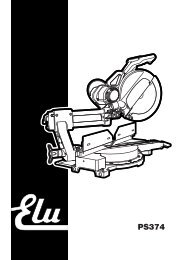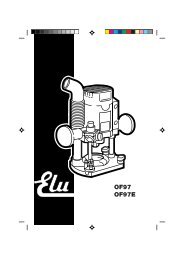Create successful ePaper yourself
Turn your PDF publications into a flip-book with our unique Google optimized e-Paper software.
ENGLISH• To switch the machine on, press the green start button (87).• To switch the machine off, press the red stop button (88).Mitre saw mode (fig. A)• To switch the machine on, keep the guard retraction lever (12)squeezed and press the trigger switch (1A).• To switch the machine off, release the trigger switch.Basic saw cutsSawing in mitre saw modeIt is dangerous to operate without guarding. Guards must be in positionwhen sawing. Always clamp the workpiece when cutting non-ferrousmetals. Use the E34906 clamp.General handling- In the mitre saw mode, the sawhead is automatically locked in theupper “park”-position.- Squeezing the head lock release lever will unlock the sawhead.- Never seek to prevent the lower guard returning to its park positionwhen the cut is completed.- The minimum length of offcut material is 10 mm.- When cutting short material (min. 190 mm to the left or the right of theblade), the use of the optional material clamp is recommended.- When cutting UPVC sections, a supporting piece made out of timberwith a complementary profile should be placed beneath the materialbeing cut to provide the correct level of support.Vertical straight cross cut (fig. S)• Set the rotating table to 0° and make sure that the locating plunger isengaged.• Pull down the rotating table clamping knob.• Place the wood to be cut against the fence. Take hold of the controlhandle and press in the head lock release lever.• Switch the machine on.• Allow the blade to cut freely. Do not force.• When the cut is completed, raise the sawhead to its rest position andpress the red stop button.Do not allow the sawhead to jump back unaided to preventdamage.Mitre cuts (fig. T)• Set the required mitre angle.• Ensure that the rotating table clamp is tightly secured.• Ensure that the depth stop limiter is correctly set to prevent the bladecutting the table if the angle is not 45°.• Proceed as for a vertical straight cross-cut.Bevel cuts (fig. U)• Release the bevel clamp handle (24) and tilt the head to the anglerequired.• Tighten the bevel clamp handle.• Proceed as for a vertical straight cross-cut.Compound mitreThis cut is a combination of a mitre and a bevel cut.The limitations are 45° mitre/30° bevel. Do not exceed these limits.• Set the bevel angle and subsequently set the mitre angle.Sawing in the bench mode• Always ensure that the riving knife and blade guard are correctly aligned.Ripping (fig. V)• Set the blade to the correct height.• The correct blade position is to have the tips of three teeth above thetop surface of the wood.• Mount the parallel fence using either the 10 mm or the 62 mm profile.The piece of wood between the fence and the blade is the retained piece.• Switch the machine on.• Slowly feed the timber underneath the front of the upper blade guard,keeping it firmly pressed against the fence. Allow the teeth to cut anddo not force the timber through the blade. The blade speed should bekept constant.Always use a push stick.• When the cut is finished, switch off by pressing the red stop button.Bevel cuts (fig. W)• Release the bevel clamp handle and set the blade to the required angle.• In order to prevent material jamming between the blade and the fence,position the fence to the left of the blade.• Proceed as for vertical ripping.Mitre cuts (fig. X1 - X3)• To adjust the mitre fence, loosen the stop screw locknut (90) andscrew the stop (91) in or out until the mitre pointer reads 0° (fig. X1).• Set the blade height and angle.• Insert the slide bar (92) of the mitre fence into the groove (93) providedin the left-hand side of the table (fig. X2).• Loosen the mitre locking knob (94) and rotate the fence to set thescale to the required angle (fig. X3).• Tighten the mitre locking knob (94).• Place the workpiece against the flat surface of the mitre fence.Switch on and, holding the workpiece firmly, slide the fence along thegroove to take the workpiece into the blade. When the cut iscompleted, switch off immediately.Fence positions, saw bench mode (fig. Y)- For ripping thin materials, use the 10 mm profile of the dual heightparallel fence and position the fence opposite the front edge of theriving knife.- For ripping thicker materials, use the 62 mm profile of the dual heightparallel fence.- For cross-cutting narrow and short workpieces (fig. Y):• Adjust the parallel fence with the low profile facing the blade andinstall the rear of the fence in line with the leading edge of the blade.• Set the workpiece against the mitre fence (at 0° or 90°) and push themitre fence to make the cut.• To prevent small offcut pieces fouling against the blade, prepare atapered length of timber and clamp it on the rear edge of theworktable close enough to the right-hand side of the blade so thatsuccessive offcuts feed automatically to the right.- For ripping narrow (< 120 mm) and long workpieces:• Place the fence in rearmost position to maintain accuracy duringlong cuts.• Push the workpiece with both hands (one on each side of the blade).• Use a push stick when close to the blade.• Support long workpieces at the outfeed side.- For ripping wider (>120 mm) workpieces:• Adjust the fence forward as in figure Y if the material being cut tendsto jam between the blade or the riving knife and the fence.24 en - 7
















